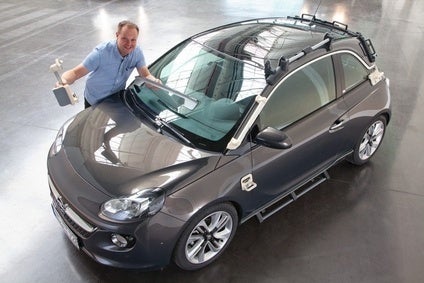
Opel says that assembly tools produced by a 3D printer are an increasingly important part of the production process.
A six-strong team led by virtual simulation engineer Sascha Holl prints plastic assembly tools in Rüsselsheim which are used in Opel manufacturing plants across Europe. Cheaper and quicker to produce, these tools are being used at Eisenach for the assembly of the Adam and its new Adam Rocks stable-mate. Opel experts predict the use of tools from a 3D printer will continue to grow. “In the future, more and more 3D assembly tools will be integrated into the production process,” said Holl.
For production of the Adam Rocks, to be launched in September, the Eisenach carmakers use an assembly jig – a specific, fixed frame – made by a 3D printer to produce the vehicle name logotype on the side window. Plus for the windshield, a 3D-printed inlet guide is also used to simplify the mounting process and help ensure a precise alignment. Other tools from the printer are used to fasten the chrome step plate on Adam Rocks door openings and install the standard Swing Top canvas roof. Around 40 such assembly aids and jigs are used in Eisenach.
This equipment was developed on the computer during the development phase of Adam Rocks. “It enables us to quickly adapt the parts. If something changes on the vehicle, we can easily modify the tool with just a few clicks,” said Holl. “The 3D printing process enables us to produce every imaginable form and shape. Unlike conventional manufacturing technology, we don’t have to accept any limitations.”
Opel says that using sophisticated technology to join a number of smaller elements, it is possible to produce larger parts. For instance, when developing an assembly aid for the side sill or the rear spoiler of Adam Rocks.
During 3D printing, plastic is melted and laid down in successive layers, each just 0.25mm thick. The plastic used is light, robust and versatile. Hollow spaces and overhangs are automatically treated with a filling material, which is later washed away in a type of dishwasher. “The process is comparable to bridge or balustrade construction,” said Holl. “There high or protruding elements must also be shored up and supported until everything has hardened off. Only then is the supporting framework removed.”

US Tariffs are shifting - will you react or anticipate?
Don’t let policy changes catch you off guard. Stay proactive with real-time data and expert analysis.
By GlobalDataThe small number of jigs required in final assembly was previously made by hand in an elaborate process using a milled cast and resin. Thanks to 3D printing, the production cost of these aids is now reduced by up to 90%, Opel says.
In addition, the printed tools are ready to use after just about eight hours, and are up to 70% lighter in weight. Another advantage is that these aids can be mechanically and chemically processed. For example, they can be drilled, milled, sanded, varnished and bonded, or connected and combined with various other materials. Ergonomic fine-tuning can also be carried out on a PC in a matter of minutes. “We can adapt the tools for each assembly situation, as well as make them user-friendly for our colleagues on the line,” added Holl.
Production of the Opel Insignia and Cascada convertible also benefits from 3D printer tools, which will be introduced step-by-step for the assembly of other Opel models. The new Corsa, Vivaro and Mokka, which will begin rolling off the assembly lines in Zaragoza later in 2014, will be among models built with the help of tools from a 3D printer. Their increasing use makes Opel a leader in this field within the GM Group.



